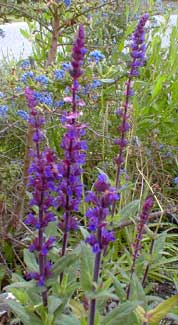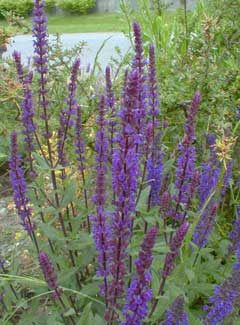
'Caradonna'
Meadow Sage
"The inevitable circle: better far
Than this, to graze the herb in thoughtless peace,
By foresight or remembrance, undisturbed!"
-William Wordsworth
(1770-1850)
(1770-1850)
 We planted the sage cultivar 'Caradonna' alongside a larger clump of the similar 'May Night' Sage in a roadside sungarden. Both of these have speedwell-like spikes of purple flowers, but 'Caradonna' is a deeper indigo purple compared to blue-violet 'May Night,' & whereas 'May Night' has green stems, 'Caradonna' has purple-black stems increasing the depth of color for each spike.
We planted the sage cultivar 'Caradonna' alongside a larger clump of the similar 'May Night' Sage in a roadside sungarden. Both of these have speedwell-like spikes of purple flowers, but 'Caradonna' is a deeper indigo purple compared to blue-violet 'May Night,' & whereas 'May Night' has green stems, 'Caradonna' has purple-black stems increasing the depth of color for each spike.The second photo was snapped in May early in its second year in our garden; the first photo is from late May its third year. One of the finest newer selections, it came from Beate Zillmer of Zillmer Nursery in Uchte, Germany. The Zillmer nursery did not plan this variety, but found it as a spontaneous sport of 'Wesuve.' The dark stems added a surprising dimension, & earned it the award of the International Hardy Plant Union for the year 2000.
'Caradonna' is always sold as a variety of S. nemerosa, though it could just as easily be lumped with the group of wild sages & their intraspecies hybrids collectively known as S. sylvestris, & taxononomists seem as yet not to have fully agreed on their precise designations.
This deer-resistant butterfly & honeybee attractant is extremely long-blooming. It will rebloom throughout summer if deadheaded, & possibly deep into autumn. It wants full sun & sharp drainage, being far more drought tolerant than damp tolerant. The species & most of its cultivars are not as sturdy in high-humidity areas where they are susceptible to mildew & floppier growth, but 'Caradonna' is improved for humidity tolerance.
The compact dark green pebbly aromatic foliage is semi-evergreen in our climate. It should be cut back in late winter to make room for new spring growth. The foliage clumps to about 18 inches. The spikes of dark-stemmed flowers are two feet to thirty inches tall. Every three or four years, or whenever the spread has reached two feet or wider, the center of the clump may begin to blacken or even die. It can be restored by digging it up, removing any scruffy bits, & dividing the remainder into smaller clumps. This can be done either in autumn or spring.
Hardy for container gardening, it also provides excellent cut flowers. Though grown primarily for ornamental rather than culinary use, young tender leaves certainly can be used in the kitchen.